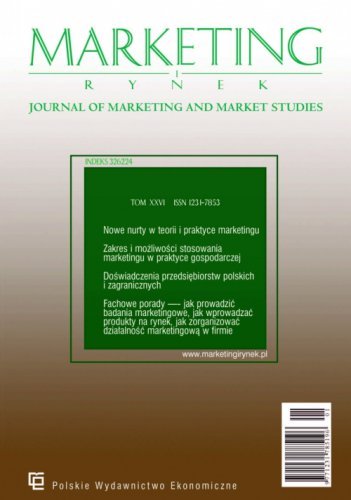Skuteczność promocji produktów z wykorzystaniem reklam holograficznych. Badanie empiryczne przy użyciu hologramów Ledholo
Podstawowym celem artykułu jest porównanie wpływu reklamy holograficznej i tradycyjnej na takie elementy zachowań konsumenckich, jak: emocje, ocena poznawcza, intencja zakupu i wrażliwość cenowa prezentowanego produktu. Przedstawiono także rys historyczny procesów tworzenia obrazów i reklam z efektem holograficznym. Wyniki przeprowadzonych badań jednoznacznie pokazują, że reklama holograficzna budzi znacznie silniejsze pozytywne emocje do prezentowanych marek i produktów niż reklama tradycyjna w formie plakatu 2D. Podobnie jest w przypadku intencji zakupu – reklama holograficzna powoduje, że konsumenci wykazują znacznie wyższą chęć dokonania zakupu produktu w porównaniu z tymi konsumentami, którym przedstawiono tradycyjną wersję reklamy. W odniesieniu do wrażliwości cenowej badania wykazały, że reklama holograficzna „usypia czujność” konsumentów poprzez silne osłabienie tej wrażliwości. Konsumenci są gotowi zapłacić więcej za reklamowany produkt w porównaniu z osobami, którym prezentowano ten sam produkt w formie plakatu.
Bibliografia
Bagozzi, R., Gopinath, M., & Nyer, P. (1999). The role of emotions in marketing. Journal of the Academy of Marketing Science, 27(2), 184–206. https://doi.org/10.1177/0092070399272005
Buck, R. (1999). Biologiczne skutki: typologia. Przegląd Psychologiczny, 106, 301–336.
Carlson, N. R. (1990a). Human Information Processing: An Introduction to Psychology. Allyn & Bacon.
Carlson, N. R. (1990b). Psychology: The Science of Behavior. Allyn and Bacon.
Carpenter, W. B. (1868). On the zoetrope and its antecedents. The Student and Intellectual Observer of Science, Literature and Art, 1, 427–444.
DeCock, B., & DePelsmacker, P. (2000). Emotions matter. W: Proceedings of the 2000 ESOMAR Conference, Rio de Janeiro, 154–179.
Dwivedi, Y. K., Ismagilova, E., Hughes, D. L., Carlson, J., Filieri, R., Jacobson, J., Jain, V., Karjaluoto, H., Kefi, H., Krishen, A. S., Kumar, V., Rahman, M. M., Raman, R., Rauschnabel, P. A., Rowley, J., Salo, J., Tran, G. A., & Wang, Y. (2021). Setting the future of digital and social media marketing
research: Perspectives and research propositions. International Journal of Information Management, 59, 102168. https://doi.org/10.1016/j.ijinfomgt.2020.102168
Erevelles, S. (1998). The role of affect in marketing. Journal of Business Research, 42(2), 199–215.
Falkowski, A. (2012). Poznawcze teorie podobieństwa w kształtowaniu wizerunku marki gospodarczej i politycznej. W: A. Falkowski, & T. Zaleśkiewicz (Red.), Psychologia poznawcza w praktyce. Ekonomia, biznes, polityka (261–332). Wydawnictwo Naukowe PWN.
Falkowski, A., & Grochowska, A. (2010). Reklama i promocja w zniekształcaniu wizerunku i pamięci marki. Marketing i Rynek, (5), 34–40.
Falkowski, A., & Mackiewicz, R. (2015). Psychologiczne aspekty wrażliwości cenowej. Perspektywa korzyści i strat. Marketing i Rynek, 22(1), 8–18.
Falkowski, A., Maruszewski, T., & Nęcka, E. (2008). Procesy poznawcze. W: J. Strelau, & D. Doliński (Red.), Psychologia: Podręcznik akademicki. Tom 1 (339–510). Gdańskie Wydawnictwo Psychologiczne.
Falkowski, A., & Tyszka, T. (2014). Psychologia zachowań konsumenckich (wyd. 2). Gdańskie Wydawnictwo Psychologiczne.
Falkowski, A., Wierucka, M., Zejdler K., & Grochowska, A. (2017). Kształtowanie wizerunku komunikacji miejskiej. Znaczenie poznawczych teorii podobieństwa w budowaniu wartości marki. Marketing i Rynek, (10), 12–22.
Frank, R. H. (2007). Mikroekonomia. Gdańskie Wydawnictwo Psychologiczne.
Haksik, L., Jaerock, L., & Harrell, G. D. (2002). Advertising and longitudinal effects on brand attitudes: The moderating roles of evaluation goals and attitude confidence. Advances in Consumer Research, 29, 173–179.
Hazlett, R. L., & Hazlett, S. Y. (1999). Emotional response to television commercials: Facial EMG vs. self-report. Journal of Advertising Research, 39(2), 7–23.
Hupp, O., Groppel-Klein, A., Dieckmann, A., Broeckelmann, P., & Walter, K. (2008). Beyond verbal scales: Measurement of emotions in advertising effectiveness research. Yearbook of Marketing and Consumer Research, 6, 72–99.
Kahneman, D. (2012). Pułapki myślenia. O myśleniu szybkim i wolnym. Media Rodzina.
Keller, K. L. (2013). Strategic Brand Management. Building, Measuring and Managing Brand Equity. Prentice Hall.
Kumar, D., & Raju, K. (2013). The role of advertising in consumer decision making. Journal of Business And Management, 14(4), 37–45.
Lavidge, R., & Steiner, G. (1961). A model of predictive measurements of advertising effectiveness. Journal of Marketing, 25(6), 59–62. https://doi.org/10.1177/002224296102500611
Lutz, R. J. (1985). Affective and cognitive antecedents of attitude toward the ad: A conceptual framework. W: L. F. Alwitt, & A. A. Mitchell (Red.), Psychological Processes and Advertising Effects: Theory, Research and Application (45–63). Erlbaum.
Mai, L., & Schoeller, G. (2009). Emotions, attitudes and memorability associated with TV commercials. Journal of Targeting, Measurement and Analysis for Marketing, 17(1), 55–63. https://doi.org/10.1057/jt.2009.1
Miller, R. L. (1962). Dr Weber and the consumer. Journal of Marketing, 26, 57–61.
Mowen, J. C. (1990). Consumer Behavior. Macmillan Publishing Company.
Page, T. J., Thorson, E. I., & Heide, M. P. (1990). The memory impact of commercials varying in emotional appeal and product involvement. W: S. J. Agres, J. A. Edell, & T. M. Dubitsky (Red.). Emotion in Advertising (255–268). Quorum Books.
Park, C., & Thorson, E. (1990). Influences on emotional response to commercials of different executional styles. W: S. Arges, J. A. Edell, & T. M. Dubitsky (Red.). Emotion in Advertising: Theoretical and Practical Explorations (162–174). Quorum Books.
Putler, D. S. (1992). Incorporating reference price effects into a theory of consumer choice. Marketing Science, 3, 287–309. https://doi.org/10.1287/mksc.11.3.287
Rauschnabel, P. A. (2021). Augmented reality is eating the real-world! The substitution of physical products by holograms. International Journal of Information Management, 57, 102279. https://doi.org/10.1016/j.ijinfomgt.2020.102279
Solomon, M., Bamossy, G., Askegaard, S., & Hogg, M. K. (2006). Consumer Behaviour: A European Perspective. Prentice Hall.
Strelau, J., & Doliński, D. (2008). Psychologia: Podręcznik akademicki. Tom 1. Gdańskie Wydawnictwo Psychologiczne.
Thompson, D. M. H., Crocker, C., & Marketo, C. G. (2010). Linking sensory characteristics to emotions: An example using dark chocolate. Food Quality Preference, 21, 1117–1125. http://dx.doi.org/10.1016/j.foodqual.2010.04.011
Wade, N. (2000). A Natural History of Vision. MIT Press.
Walker, D., & Dubitsky, T. M. (1994). Why liking matters. Journal of Advertising Research, 34(3), 9–18.
Wertheimer, M. (1912). Experimentelle Studien über das Sehen von Bewegung. Zeitschrift für Psychologie, 61(1), 161–265.
Woodworth, R. S., & Schlosberg, H. (1963). Psychologia eksperymentalna. Tom 1. PWN.
Yim, M. Y. C., Cicchirillo, V. J., & Drumwright, M. E. (2012). The impact of stereoscopic threedimensional (3–D) advertising. Journal of Advertising, 41(2), 113–128. https://doi.org/10. 2753/joa0091-3367410208

